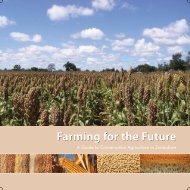Restoring the Soil - Canadian Foodgrains Bank
Restoring the Soil - Canadian Foodgrains Bank
Restoring the Soil - Canadian Foodgrains Bank
You also want an ePaper? Increase the reach of your titles
YUMPU automatically turns print PDFs into web optimized ePapers that Google loves.
Using The Decision Tree276. Using The Decision TreeHow to Use <strong>the</strong> Decision TreeThe following decision tree should not be seen as a straitjacket. It should be used toget new ideas, but not to restrict what you can do. The options given may be expandedon. O<strong>the</strong>r species can be tried. That said, <strong>the</strong> gm/cc systems listed in this decisiontree are definitely worth a try. Nearly all of <strong>the</strong>m are proven systems that hundreds offarmers have used for years, usually in <strong>the</strong> absence of any outside program. In manycases, thousands of farmers have used <strong>the</strong>m for centuries.Green Manure/Cover Crop Systems Included in <strong>the</strong> Decision TreeThe gm/cc systems included in this decision tree are almost all systems that ei<strong>the</strong>r I orGabino Lopez, a Guatemalan colleague, have observed during our more than 25 yearsof observing gm/cc systems around <strong>the</strong> world. Thus we know <strong>the</strong> systems, have a feelfor <strong>the</strong> situations in which <strong>the</strong>y have prospered, and have been able to interview farmersusing <strong>the</strong>se systems. The list includes systems that are used in about 25 developingcountries. Obviously, <strong>the</strong>re must be many systems that we have not observed in<strong>the</strong>se countries, and additional systems most likely exist in approximately ano<strong>the</strong>r 60developing countries.This list includes only gm/cc systems that use legumes. It does not include nonleguminousgm/ccs such as <strong>the</strong> oats, forage turnip (Raphanus sativa) and sunflowersoften used in South America, <strong>the</strong> fonio used in West Africa or <strong>the</strong> three-year cassavaused in Vietnam. It also does not include <strong>the</strong> vast majority of gm/cc systems based ontree species in agro-forestry systems, which are also extremely common around <strong>the</strong>developing world. 12 In most cases, <strong>the</strong> number of farmers mentioned is only a roughestimate, since it has often been 10 to 20 years since Gabino or I visited <strong>the</strong>se systems.The gm/cc systems are distinguished from each o<strong>the</strong>r by <strong>the</strong> species of gm/cc thatis used, by <strong>the</strong> cash or subsistence crop, or by <strong>the</strong> date of planting or managementof each system. When essentially <strong>the</strong> same gm/cc system is used in more than onecountry or continent, I will describe <strong>the</strong> system only once and list <strong>the</strong> o<strong>the</strong>r places it ispracticed. In many cases, especially when gm/ccs are used in rotations or to recuperatewastelands, <strong>the</strong>y are associated with any of a number of traditional crops. In <strong>the</strong>secases, each gm/cc species is counted as one system.Characteristics of <strong>the</strong> Green Manure/Cover Crop Systems RecommendedAs mentioned, <strong>the</strong> gm/cc systems included in this decision tree are those that haveproven <strong>the</strong>mselves most successful among smallholder farmers, according to twocriteria. The first is that <strong>the</strong>ir use has spread fairly widely. A particularly dramatic casewould be that of S1, <strong>the</strong> maize/mucuna system in Mexico and Central America,12Cairns, Malcolm, ed., Voices from <strong>the</strong> Forest, Integrating Indigenous Knowledge into Sustainable Upland Farming (Washington,D.C.: Resources for <strong>the</strong> Future, 2007).
















